Coral Snake (original) (raw)
“Red touches yellow, kill a fellow…” isn’t always accurate.
Coral snakes are highly venomous members of the Elapidae family. They’re split into Old World and New World groups, most of which inhabit sparsely populated areas. They’re generally small snakes, between 2 and 4 feet; the Arizona coral snake is sometimes thinner than a pencil.
The Old World groups live in Asia, India, and the islands of Southeast Asia. These snakes are classified into three genera, with about 20 species. They exhibit the widest variation in color patterns, from mostly blackish-blue with orange on their head and tail.
The New World coral snakes live in the Americas, in the southern United States, and throughout Central and South America. Many of them have red, yellow, and black patterns but not all. Of all the coral snake species, the Americas are home to by far the largest variety. There are dozens of species, over 100; however, with all that variety, they are only classified into two genera.
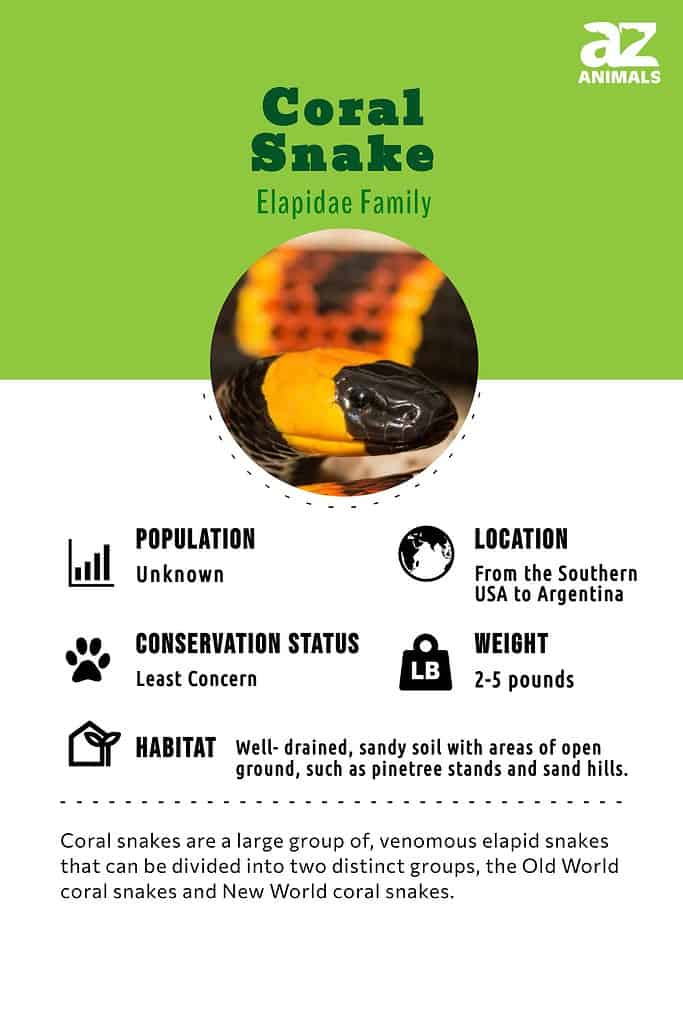
Amazing Facts About Coral Snakes
- Coral snakes are highly venomous, second behind black mambas, but their venom delivery system is lacking; their fangs are small and weak and not hollow like a pit viper’s fangs.
- In North America, they’re the only venomous snakes to lay eggs. The others are all pit vipers that give birth.
- Many coral snakes spend their time buried in leaf litter or otherwise hiding; they wait for their prey to come to them.
- A few species are aquatic; their tails are flattened and act as a paddle.
Where to Find Them
Coral snakes inhabit the Americas, like in Alabama, and many areas of India, Asia, and the islands of Southeast Asia. These snakes vary widely in behavior but are mostly fossorial, digging into leaf litter and hiding in abandoned burrows. Many do not come out except to breed or during the rainy season. A few are mostly aquatic and spend most of their time in the water with dense vegetation.
They mainly eat rodents but will also eat salamanders, frogs, lizards, birds, and occasionally other snakes. Some species, like the blue Malaysian coral snake, eats primarily snakes.
Scientific Name
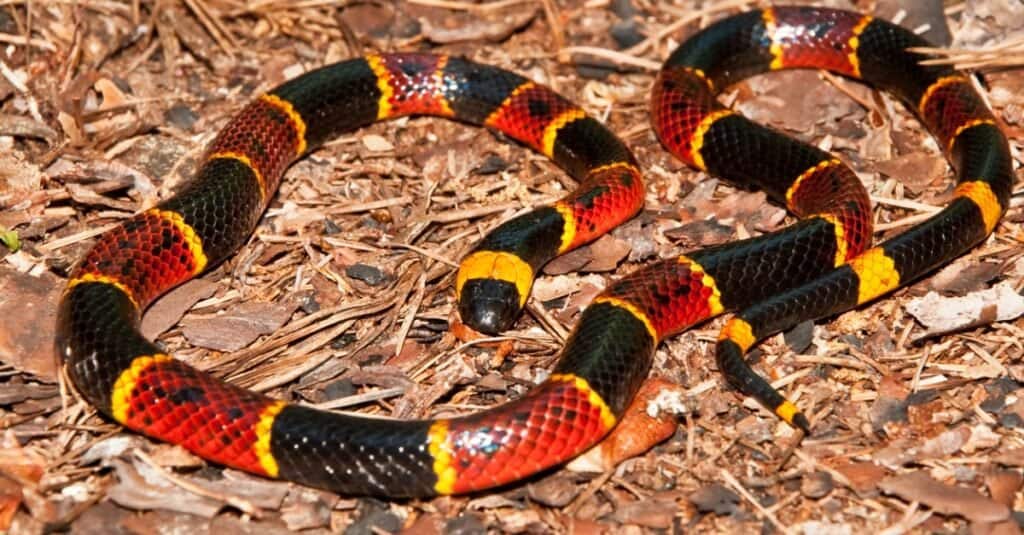
Coral snakes are brightly colored and have distinctive bands.
©iStock.com/JasonOndreicka
They’re part of the Elapidae family, cousins to snakes like cobras and mambas. Coral snakes are classified under several genera, all with different meanings:
- Calliophis is Greek and means beautiful (calli = beautiful) snake (ophis).
- Hemibungarus
- Sinomicrurus means Chinese (sino = from China) small (micr = small) tail (urus = tail).
- Micrurus means small tail.
- Micruoides means small tail-like.
Each of the specific names either gives further detail about the snake’s physical description or honors a person involved in its discovery.
Population and Conservation
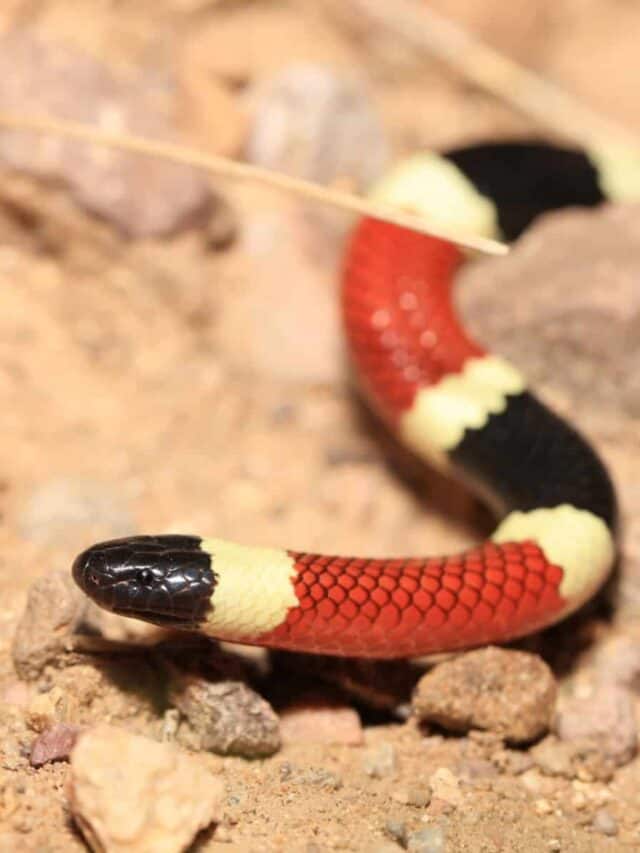
Coral snakes do not reproduce quickly, having only 2-3 eggs at once.
Coral snakes don’t breed very quickly – many only lay 2 or 3 eggs at a time. Some coral snakes are considered endangered in part of their habitat; for example, North Carolina considers the eastern coral snake (M. fulvius) endangered. The IUCN Redlist has several listed as vulnerable with decreasing populations; including the Roatan coral snake (M. ruatanus), the Oaxacan coral snake (M. ephippifer), and the Japanese coral snake (S. japonicus).
Appearance & Description
The rhyme many school kids learned works most of the time for the Eastern and Texas coral snakes; it sort of works with the Arizona species, which often has white bands instead of yellow. It’s not completely reliable, however, and the further you go from the United States, the less it works. Add to that, several snake species mimic coral snake colors, such as the king snakes and milk snakes that have similar banding.
So, learning to identify the coral snakes that live in your area is the best way to go.
Snakes such as the eastern, Texas, and Arizona coral snakes do have a couple of things in common: They have blunt heads and tails, and their color pattern extends all the way around their bodies. The non-venomous look-alikes’ color stops at their bellies.
The rhyme doesn’t work at all with Asian species; their colors and patterns vary greatly from species to species.
Diet
Coral snakes have an interesting diet that primarily consists of small reptiles, rodents, and even frogs. They are mostly ground-dwellers, so they hunt for their prey in the leaf litter or soil on the forest floor. They sometimes use ambush tactics to surprise their prey when they least expect it. Coral snakes also feed on other venomous snakes, such as rattlesnakes and copperheads, which gives them a competitive advantage over other predators who can’t tolerate the venom of these species. However, coral snakes will occasionally take advantage of birds and insects if they get hungry enough!
Read about what coral snakes eat.
Pictures and Videos
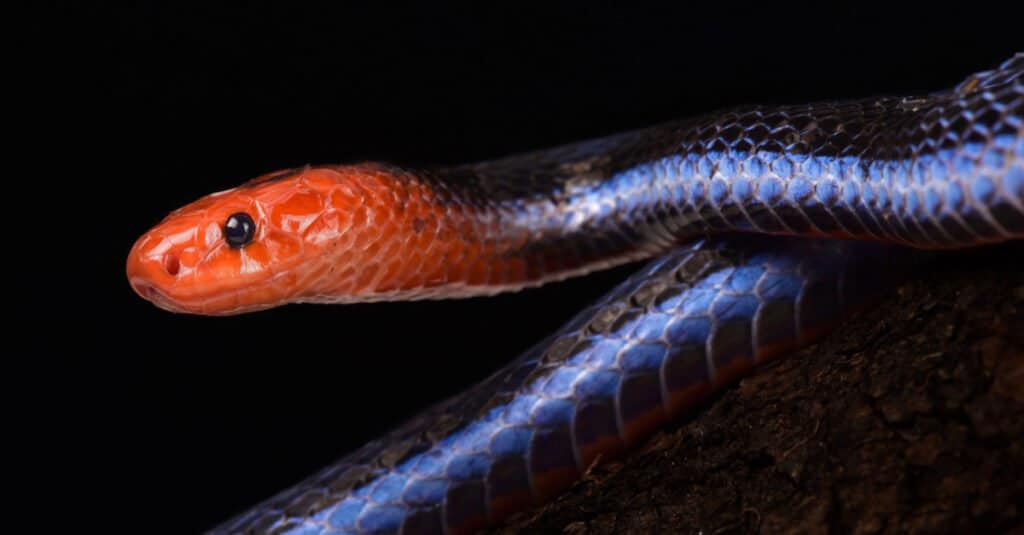
The blue Malaysian coral snake is blue-black with red on its head and tail.
©reptiles4all/Shutterstock.com
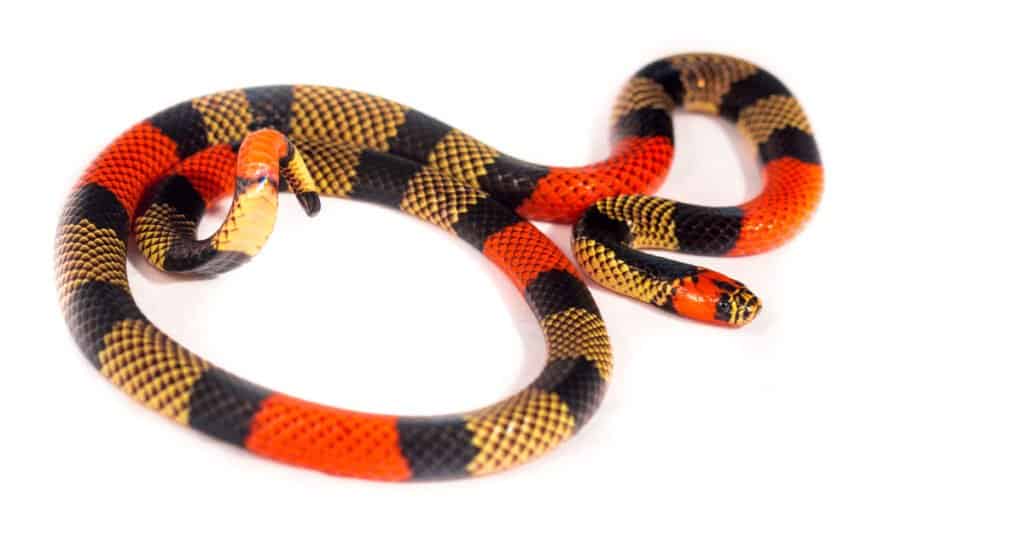
Amazon coral snakes have wide yellow bands with black speckles.
©vampflack/Shutterstock.com
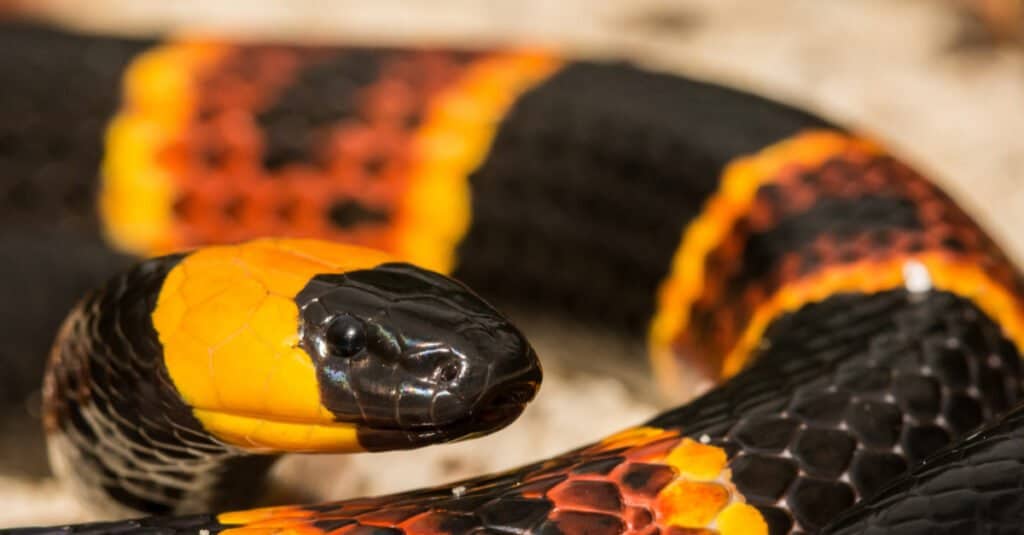
Eastern coral snakes typically have black coloring until right behind the eyes. The first death due to these snakes in over 40 years occurred in 2009.
©Jay Ondreicka/Shutterstock.com
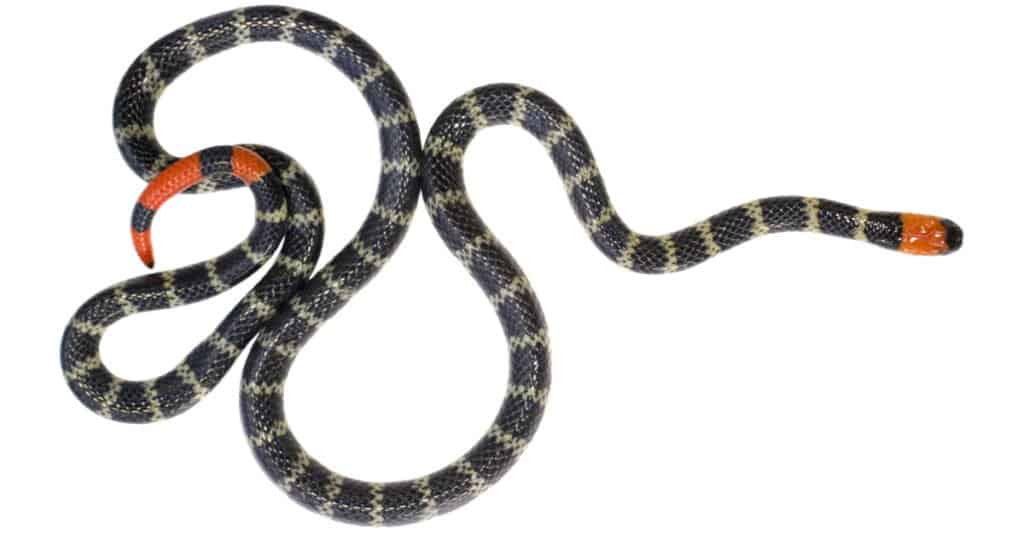
Like many of the New World species, red-tailed coral snakes exhibit black on their head that stops just behind the eyes. (Micrurus mipartitus decussatus)
©Dr. Morley Read/Shutterstock.com
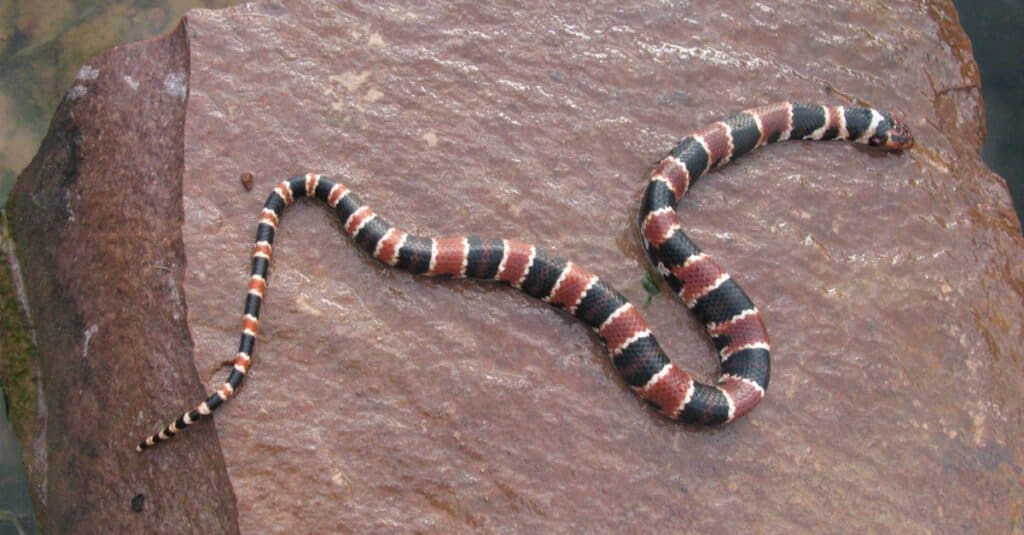
These coral snakes have narrow white bands instead of the yellow of other species.
©guentermanaus/Shutterstock.com
Venom: How Dangerous are They?
Despite their highly toxic venom and fearsome reputation, North American coral snakes are considered less dangerous than rattlesnakes and copperheads. Their venom is the second most toxic in the world after black mambas and is composed of neurotoxins that attack the respiratory system. A severe bite can cause death in just a few hours, which makes immediate medical care vital.
Toxicity of their venom aside, these snakes have a poor venom delivery system. Unlike vipers, coral snakes don’t have hollow fangs attached to a venom gland. Their fangs have a groove that the venom travels down when they bite; rather than striking and releasing, coral snakes have to chew on their prey to get venom injected.
Behavior and Humans
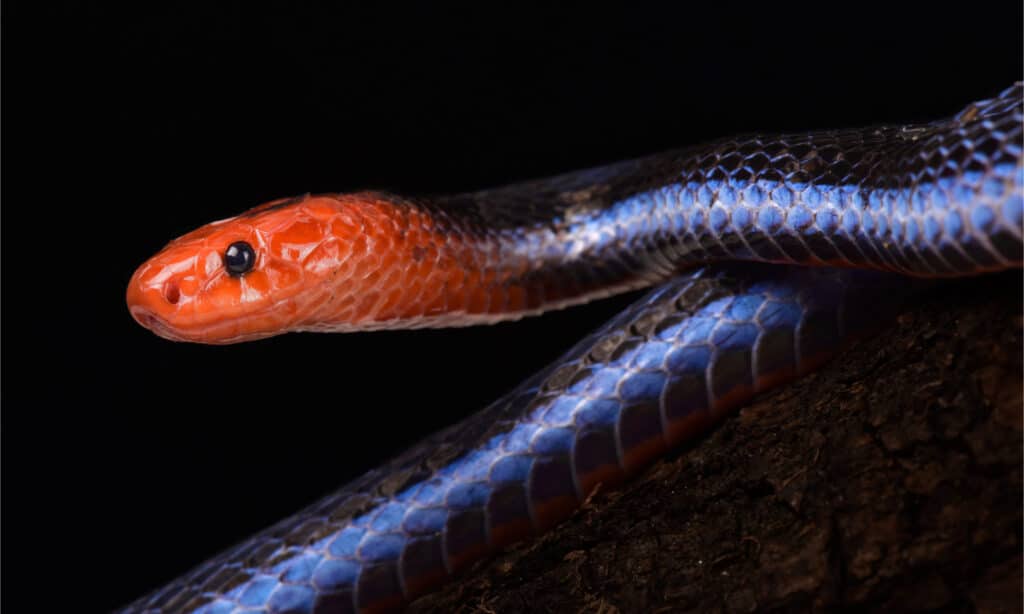
Coral snakes are highly venomous but not aggressive.
©reptiles4all/Shutterstock.com
Coral snakes are highly venomous, but surprisingly few bites occur every year. Unlike the mambas and cobras, their less reclusive cousins, they are excellent escape artists and often leave before you ever have a chance to see them. If you do see one, your best bet is to back away and give it space to leave; they’re not generally aggressive and will not chase you.
They’re reclusive and spend much of their time buried in leaf litter, underground, or otherwise hidden on the rainforest floor. Over 90% of the bites incurred happen after someone picks up one of these snakes.
As with other dangerous animals, only those with proper training and experience should handle them.
181 Types of Coral Snakes

These coral snakes have narrow white bands instead of the yellow of other species.
©guentermanaus/Shutterstock.com
There are two groups of coral snakes, New World and Old World.
The main difference between the old world and new world coral snakes is their geographic location. Old-world coral snakes are found in Africa, the Middle East, India, and parts of Southeast Asia. New World coral snakes can be found in North America, Central America, and South America. An additional difference is that most new World coral snake species have red bands bordered by black rings, while most old World species have yellow or white bands separated by black rings. Furthermore, some new World species can be distinguished from others by differences in color patterns and head shape. For example, Eastern Coral Snakes typically have a more triangular head with bright, striking colors compared to the Western Coral Snake, which has a more rounded head and duller colors.
| Old World Coral Snakes | Genus Calliophis |
|---|---|
| Beddome’s Coral Snake | C. beddomei |
| Bibron’s Coral Snake | C. bibroni |
| Castoe’s Coral Snake | C. castoe |
| Black coral snake | C. nigrescens |
| Indian coral snake | C. melanurus |
| Blood-bellied coral snake | C. haematoetron |
| Dinagat Island banded coral snake | C. salitan |
| Malaysian banded coral snake | C. intestinalis |
| Malaysian blue coral snake | C. bivirgatus |
| Spotted coral snake | C. gracilis |
| Speckled coral snake | C. maculiceps |
| Old World Coral Snakes | Genus Hemibungarus |
|---|---|
| Barred coral snake | H. calligaster |
| Barred coral snake | H. gemianulis |
| Old World Coral Snakes | Genus Sinomicrurus |
|---|---|
| _Japanese c_oral snake | S. japonicus |
| Kellogg’s coral snake | S. kelloggi |
| McClelland’s coral snake | S. macclellandi |
| Sinomicrurus hatori | S. hatori |
| Sinomicrurus sauteri | S. sauteri |
| New World Coral Snakes | Genus Leptomicrurus |
|---|---|
| Blackback coral snake | l. collairs |
| Leptomicrurus collaris collaris | l. collaris collaris |
| Leptomicrurus collaris breviventris | l. collaris breviventris |
| Andean Blackback Coral Snake | l. narduccii |
| Leptomicrurus narduccii narduccii | l. narduccii narduccii |
| Leptomicrurus narduccii melanotus | l. narduccii melanotus |
| New World Coral Snakes | Genus Micruroides |
|---|---|
| Arizona coral sake | m. euryxanthus |
| Micruroides euryxanthus australis | m. euryxanthus australis |
| Micruroides euryxanthus euryxanthus | m. euryxanthus euryxanthus |
| Micruroides euryxanthus neglectus | m. euryxanthus neglectus |
| New World Coral Snakes | Genus Micrurus |
|---|---|
| Allen’s coral sake | m. alleni |
| Micrurus alleni alleni | m. alleni alleni |
| Micrurus alleni richardi | m. alleni richardi |
| Micrurus alleni yatesi | m. alleni yatesi |
| Micrurus altirostris | m. altirostris |
| Regal coral snake | m. ancoralis |
| Micrurus ancoralis jani | m. ancoralis jani |
| Micrurus ancoralis ancoralis | m. ancoralis ancoralis |
| Annellated coral snake | m. annellatus |
| Micrurus annellatus annellatus | m. annellatus annellatus |
| Micrurus annellatus balzanii | m. annellatus balzanii |
| Micrurus annellatus bolivianus | m. annellatus bolivianus |
| Black-headed coral snake | m. averyi |
| Micrurus bernadi | m. bernadi |
| Ecuadorian coral snake | m. bocourti |
| Bogert’s coral snake | m. bogerti |
| Brown’s coral snake | m. browni |
| Micrurus browni browni | m. browni browni |
| Micrurus browni importunus | m. browni importunus |
| Micrurus browni Taylori | m. browni Taylori |
| Micrurus camilae | m. camilae |
| Catamayo coral snake | m. catamayensis |
| Clark’s coral snake | m. clarki |
| Painted coral snake | m. corallinus |
| Brazilian coral snake | m. decoratus |
| Micrurus diana | m. diana |
| Variable coral snake | m. diastema |
| Micrurus diastema diastema | m. diastema diastema |
| Micrurus diastema aglaeope | m. diastema aglaeope |
| Micrurus diastema alienus | m. diastema alienus |
| Micrurus diastema affinis | m. diastema affinis |
| Micrurus diastema apiatus | m. diastema apiatus |
| Micrurus diastema macdougalli | m. diastema macdougalli |
| Micrurus diastema sapperi | m. diastema sapperi |
| Pygmy coral snake | m. dissoleucus |
| Micrurus dissoleucus dissoleucus | m. dissoleucus dissoleucus |
| Micrurus dissoleucus dunni | m. dissoleucus dunni |
| Micrurus dissoleucus melanogenys | m. dissoleucus melanogenys |
| Micrurus dissoleucus meridensis | m. dissoleucus meridensis |
| Micrurus dissoleucus nigrirostris | m. dissoleucus nigrirostris |
| West Mexican coral snake | m. distans |
| Micrurus distans distans | m. distans distans |
| Micrurus distans michoacanensis | m. distans michoacanensis |
| Micrurus distans oliveri | m. distans oliveri |
| Micrurus distans zweifeli | m. distans zweifeli |
| Micrurus dumerilii | m. dumerilii |
| Micrurus dumerili antioquiensis | m. dumerili antioquiensis |
| Micrurus dumerili carinicaudus | m. dumerili carinicaudus |
| Micrurus carinicauda | m. carinicauda |
| Micrurus dumerili colombianus | m. dumerili colombianus |
| Micrurus dumerili transandinus | m. dumerili transandinus |
| Micrurus dumerili venezuelensis | m. dumerili venezuelensis |
| Elegant coral snake | m. elegans |
| Micrurus elegans elegans | m. elegans elegans |
| Micrurus elegans veraepacis | m. elegans veraepacis |
| Oaxcan coral snake | m. ephippifer |
| Micrurus ephippifer zapotecus | m. ephippifer zapotecus |
| Micrurus ephippifer ephippifer | m. ephippifer ephippifer |
| Slender coral snake | m. filiformis |
| Micrurus filiformis filiformis | m. filiformis filiformis |
| Micrurus filiformis subtilis | m. filiformis subtilis |
| Southern coral snake | m. frotalis |
| Micrurus frontalis frontalis | m. frontalis frontalis |
| Micrurus frontalis brasiliensis | m. frontalis brasiliensis |
| Micrurus frontalis mesopotamicus | m. frontalis mesopotamicus |
| Bolivian coral snake | m. frontifasciatus |
| Easter coral snake | m. fulvius |
| Hemprich’s coral snake | m. hemprichii |
| Micrurus hemprichii hemprichii | m. hemprichii hemprichii |
| Micrurus hemprichii ortoni | m. hemprichii ortoni |
| Micrurus hemprichii rondonianus | m. hemprichii rondonianus |
| Mayan coral snake | m. hippocrepis |
| Caatinga coral snake | m. ibiboboca |
| Venezuela coral snake | m. isozonus |
| Langsdorff’s coral snake | m. langsdorffi |
| Micrurus langsdorffi langsdorffi | m. langsdorffi langsdorffi |
| Micrurus langsdorffi ornatissimus | m. langsdorffi ornatissimus |
| Balsan coral snake | m. laticollaris |
| Micrurus laticollaris laticollaris | m. laticollaris laticollaris |
| Micrurus laticollaris maculirostris | m. laticollaris maculirostris |
| Broad-ringed coral snake | m. latifasciatus |
| South-American coral snake | m. lemniscatus |
| Micrurus lemniscatus lemniscatus | m. lemniscatus lemniscatus |
| Micrurus lemniscatus carvalhoi | m. lemniscatus carvalhoi |
| Micrurus lemniscatus diutius | m. lemniscatus diutius |
| Micrurus lemniscatus frontifasciatus | m. lemniscatus frontifasciatus |
| Micrurus lemniscatus helleri | m. lemniscatus helleri |
| Tuxtlan coral snake | m. limbatus |
| Micrurus limbatus limbatus | m. imbatus limbatus |
| Micrurus limbatus spilosomus | m. limbatus spilosomus |
| Speckled coral snake | m. margaritiferus |
| Micrurus medemi | m. medemi |
| Merten’s coral snake | m. mertensi |
| Redtail coral snake | m. mipartitus |
| Micrurus mipartitus mipartitus | mipartitus mipartitus m. mipartitus mipartitus |
| Micrurus mipartitus anomalus | m. mipartitus anomalus |
| Micrurus mipartitus decussatus | m. mipartitus decussatus |
| Micrurus mipartitus semipartitus | m. mipartitus semipartitus |
| Many-banded coral snake | m. multifasciatus |
| Micrurus multifasciatus multifasciatus | m. multifasciatus multifasciatus |
| Micrurus multifasciatus hertwigi | m. multifasciatus hertwigi |
| Cauca coral snake | m. multiscutatus |
| Cloud forest coral snake | m. nebularis |
| Central American coral snake | m. nigrocinctus |
| Micrurus nigrocinctus babaspul | m. nigrocinctus babaspul |
| Micrurus nigrocinctus coibensis | m. nigrocinctus coibensis |
| Micrurus nigrocinctus divaricatus | m. nigrocinctus divaricatus |
| Micrurus nigrocinctus mosquitensis | m. nigrocinctus mosquitensis |
| Micrurus nigrocinctus nigrocinctus | m. nigrocinctus nigrocinctus |
| Micrurus nigrocinctus ovandoensis | m. nigrocinctus ovandoensis |
| Micrurus nigrocinctus wagneri | m. nigrocinctus wagneri |
| Micrurus nigrocinctus yatesi | m. nigrocinctus yatesi |
| Micrurus nigrocinctus zunilensis | m. nigrocinctus zunilensis |
| Micrurus pacaraimae | m. pacaraimae |
| Micrurus pachecogili | m. pachecogili |
| Micrurus paraensis | m. paraensis |
| Peruvian coral snake | m. peruvianus |
| Peter’s coral snake | m. petersi |
| Nayarit coral snake | m. proximans |
| Carib coral snake | m. psyches |
| Micrurus psyches circinalis | m. psyches circinalis |
| Micrurus psyches donosoi | m. psyches donosoi |
| Micrurus psyches psyches | m. psyches psyches |
| Putumayo Coral Snake | m. putumayensis |
| Micrurus pyrrhocryptus | m. pyrrhocryptus |
| Micrurus remotus | m. remotus |
| Micrurus renjifoi | m. renjifoi |
| Roatan Coral Snake | m. ruatanus |
| Santander Coral Snake | m. sangilensis |
| Micrurus scutiventris | m. scutiventris |
| Micrurus silviae | m. silviae |
| Amazon Coral Snake | m. spixii |
| Micrurus spixii spixii | m. spixii spixii |
| Micrurus spixiii martiusi | m. spixiii martiusi |
| Micrurus spixii obscurus | m. spixii obscurus |
| Micrurus spixii princeps | m. spixii princeps |
| Micrurus spurelli | m. spurelli |
| Steindachner’s Coral Snake | m. Coral Snake |
| Micrurus steindachneri steindachneri | m. steindachneri steindachneri |
| Micrurus steindachneri orcesi | m. steindachneri orcesi |
| Panamanian coral snake | m. stewarti |
| Stuart;s coral snake | m. stuarti |
| Aquatic coral snake | m. surinamensis |
| Micrurus surinamensis surinamensis | m. surinamensis surinamensis |
| Micrurus surinamensis nattereri | m. surinamensis nattereri |
| Micrurus tamaulipensis | m. tamaulipensis |
| Texas coral snake | m. tener |
| Micrurus tener fitzingeri | m. tener fitzingeri |
| Micrurus tener maculatus | m. tener maculatus |
| Micrurus tener microgalbineus | m. tener microgalbineus |
| Micrurus tener tener | m. tener tener |
| Micrurus tricolor | m. tricolor |
| Desert coral snake | m. tschudii |
| Micrurus tschudii olssoni | m. tschudii olssoni |
| Micrurus tschudii tschudii | m. tschudii tschudii |
View all 336 animals that start with C
Yes! Like all members of the Elapidae family, which includes cobras and mambas, coral snakes are highly venomous.
There’s a lot that isn’t known. We know that many coral snake species love to eat other snakes (including their own), and when they strike, they hold on so that snake they’re trying to eat can’t get away.
These snakes aren’t aggressive, they spend most of their time underground and generally avoid people.
Most species are in the Americas, but Asia has 3 genera.
It depends. Most eat mice, rats, and birds; some specialize in eating others snakes, and the aquatic species eat fish.
A coral snake is more venomous than a cottonmouth snake.
The main differences between a coral snake and a copperhead lie in their size, taxonomy, venom yield, fang type, and diet among others.
The key difference between the coral snake and corn snake is that the coral snake is venomous, while the corn snake is not.